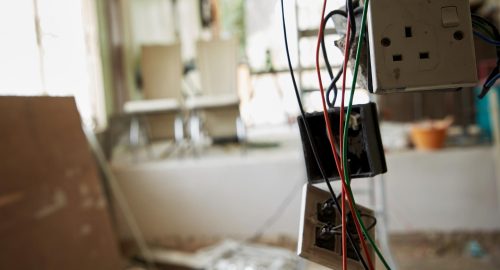Understanding the basics of electrical panel installation can help ensure our homes are safe and functional. The electrical panel, sometimes known as the breaker box or distribution board, is the central hub that directs electrical power from the main supply to various circuits in our homes. This crucial component manages the electrical load and ensures the safe distribution of electricity to different parts of the house.
Over time, electrical panels may require upgrades or replacements to keep up with increased power demands or to address safety concerns. Knowing the role of an electrical panel and the installation process can help homeowners make informed decisions. It also underlines the importance of relying on our professionals to handle this intricate task, given the safety protocols and technical expertise involved.
Understanding the Role of an Electrical Panel
An electrical panel, often called a breaker box or distribution board, serves as the central point where electricity enters our home from the main supply line. This panel houses circuit breakers that control the electrical flow to different parts of the house. Each breaker corresponds to a specific circuit and can shut off power if an overload is detected or if maintenance is needed.
The electrical panel is vital for ensuring that electricity is distributed safely and efficiently. It helps protect our home from electrical hazards such as fires and shocks by tripping breakers when an overload or short circuit occurs. This protection minimizes the risk of damage to appliances and wiring, contributing to the overall safety of the home. Understanding the role of the electrical panel underscores the need for regular maintenance and timely upgrades to meet modern electrical requirements.
Steps Involved in Electrical Panel Installation
Installing an electrical panel involves several detailed steps that must be followed carefully to ensure safety and functionality. Here’s an outline of the installation process:
- Planning and Permitting: Before installation begins, we need a detailed plan outlining the electrical requirements of our home. This plan must comply with electrical codes and may require permits from regulatory bodies. Proper planning ensures that the installation meets safety standards and accommodates the electrical load of our home.
- Shutting Off Power: To ensure safety, the power supply to the home is turned off before any work begins. This step is crucial to prevent electrical shocks and other hazards during the installation process.
- Removing the Old Panel: If an existing panel needs to be replaced, our professionals carefully disconnect and remove it. This involves detaching all the wires and components connected to the old panel.
- Mounting the New Panel: The new electrical panel is securely mounted in place. Ensuring that it is level and firmly attached to the wall is essential for safety and accessibility.
- Connecting the Wires: Each wire is carefully routed and connected to the appropriate breaker in the new panel. This step requires precision to ensure that all connections are secure and that the electrical distribution is correctly configured.
- Testing and Inspection: Once all connections are made, the system is tested to ensure everything works correctly. Our professionals also inspect the work to ensure that it complies with all safety standards and regulations.
Key Components of an Electrical Panel
Understanding the key components of an electrical panel helps us appreciate its functionality and importance. Here are the main parts that make up an electrical panel:
- Circuit Breakers: These are switches that automatically shut off power to a circuit if there is an overload or short circuit. They help protect the electrical system and connected devices from damage. Each breaker controls a specific circuit, ensuring the safe distribution of electricity.
- Bus Bars: These metal strips conduct electricity within the panel and distribute it to the individual circuit breakers. There are typically two bus bars: one for connecting the neutral wires and another for the live wires. Proper connections to the bus bars ensure efficient power distribution.
- Neutral and Grounding Bars: The neutral bar is where all the neutral wires from various circuits connect. The grounding bar provides a path to safely divert any excess electricity into the ground, protecting the system from electrical faults and potential shocks.
- Main Breaker: This larger breaker controls the flow of electricity from the main power supply to the electrical panel. It can shut off power to the entire panel if needed, serving as a crucial safety feature.
- Service Entry Wire: These wires bring electricity from the utility company to the electrical panel. They connect to the main breaker and distribute power to the individual circuit breakers.
Common Signs Your Electrical Panel Needs an Upgrade
Recognizing the signs that indicate your electrical panel needs an upgrade is crucial for maintaining a safe and efficient electrical system. Here are some common indicators that it’s time to consider an upgrade:
- Frequent Breaker Trips: If the circuit breakers trip frequently, it suggests that the electrical panel is overloaded or there are underlying issues with the wiring. Regular trips are inconvenient and signal that the panel may not be handling the home’s current electrical demands.
- Flickering or Dimming Lights: When lights dim or flicker often, it may indicate that the panel is struggling to distribute power evenly. This issue can arise from poor connections, outdated components, or an overloaded system.
- Outdated Panels: Older electrical panels might not meet current electrical codes or handle modern electrical loads. Panels with fuses instead of circuit breakers, or those that are 20-30 years old, generally need replacement to meet today’s safety standards.
- Burning Smells or Scorch Marks: Any burning smell or visible scorch marks around the electrical panel or outlets indicate serious issues that need immediate attention. These signs point to overheating or short circuits, which can lead to electrical fires.
Conclusion
Understanding the basics of electrical panel installation and its components is essential for maintaining a safe and functional home. Recognizing the signs that indicate the need for an upgrade ensures that our electrical system can handle modern demands and operate efficiently. Proper installation and routine maintenance by our professionals ensure that all components function correctly and safely.
Professional electrical panel installation in Minneapolis is crucial for the safety and reliability of our home’s electrical system. Relying on our experts helps prevent potential hazards and ensures compliance with all safety standards and regulations. For homeowners seeking top-notch electrical services, our team at Stafford Home Service Inc. is here to help. Contact us today to schedule an inspection or upgrade of your electrical panel, ensuring your home remains safe and powered efficiently.








